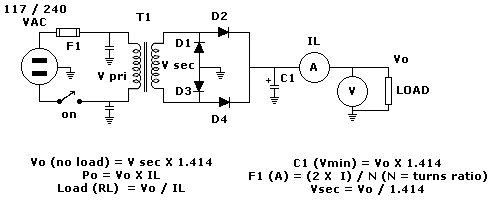|
|
|
|
Power Supply design - Part 1 |
|
|
|
|
|
Power Supply design - Part 1 |
|
Below is the circuit of a basic unregulated dc power supply. The ac from the transformer secondary is rectified by a bridge rectifier D1 to D4 which may also be a block rectifier such as WO4 or even four individual diodes such as 1N4004 types. (see later re rectifier ratings).
The principal advantage of a bridge rectifier is you do not need a centre tap on the secondary of the transformer. A further but significant advantage is that the ripple frequency at the output is twice the line frequency (i.e. 50 Hz or 60 Hz) and makes filtering somewhat easier.

As a design example consider we wanted a small unregulated bench supply for our projects. Here we will go for a voltage of about 12 - 13V at a maximum output current (IL) of 500ma (0.5A). Maximum ripple will be 2.5% and load regulation is 5%.
Now the rms secondary voltage (primary is whatever is consistent with your area) for our power transformer T1 must be our desired output Vo PLUS the voltage drops across D2 and D4 ( 2 * 0.7V) divided by 1.414.
This means that Vsec = [13V + 1.4V] / 1.414 which equals about 10.2V. Depending on the VA rating of your transformer, the secondary voltage will vary considerably in accordance with the applied load. The secondary voltage on a transformer advertised as say 20VA will be much greater if the secondary is only lightly loaded.
If we accept the 2.5% ripple as adequate for our purposes then at 13V this becomes 13 * 0.025 = 0.325 Vrms. The peak to peak value is 2.828 times this value. Vrip = 0.325V X 2.828 = 0.92 V and this value is required to calculate the value of C1. Also required for this calculation is the time interval for charging pulses. If you are on a 60Hz system it it 1/ (2 * 60 ) = 0.008333 which is 8.33 milliseconds. For a 50Hz system it is 0.01 sec or 10 milliseconds.
The formula for C1 is:
C1 (uF) = [ ( IL * t ) /
Vrip ] X 106
C1 = [ ( 0.5A X 0.00833 ) / 0.92V ] X 106
C1 = 0.00453 X 106 = 4529 or 4700 uF
Remember the tolerance of the type of capacitor used here is very loose. The important thing to be aware of is the voltage rating should be at least 13V X 1.414 or 18.33. Here you would use at least the standard 25V or higher (absolutely not 16V).
With our rectifier diodes or bridge they should have a PIV rating of 2.828 times the Vsec or at least 29V. Don't search for this rating because it doesn't exist. Use the next highest standard or even higher. The current rating should be at least twice the load current maximum i.e. 2 X 0.5A or 1A. A good type to use would be 1N4004, 1N4006 or 1N4008 types. These are rated 1 Amp at 400PIV, 600PIV and 1000PIV respectively. Always be on the lookout for the higher voltage ones when they are on special.
TRANSFORMER RATING - In our example above we were taking 0.5A out of the Vsec of 10V. The VA required is 10 X 0.5A = 5VA. This is a small PCB mount transformer available in Australia and probably elsewhere. This would be an absolute minimum and if you anticipated drawing the maximum current all the time then go to a higher VA rating.
The two capacitors in the primary side are small value types and if you don't know precisely and I mean precisely what you are doing then OMIT them. Their loss won't cause you heartache or terrible problems.
The fuse F1 must be able to carry the primary current but blow under excessive current, in this case we use the formula from the diagram. Here N = 240V / 10V or perhaps 120V / 10V. The fuse calculates in the first instance to [ 2 X 0.5A ] / [240 / 10] or .04A or 40 ma. In the second case .08A or 80 ma. The difficulty here is to find suitable fuses of that low a current and voltage rating. In practice you use the closest you can get (often 100 ma ). Don't take that too literal and use 1A or 5A fuses.
CONSTRUCTION
- The whole project MUST be enclosed in a suitable box. The main switch
(preferably double pole) must be rated at 240V or 120V at the current rating.
All exposed parts within the box MUST be fully insulated, preferably with heat
shrink tubing.
Collin's Home Page Colin's Amateur Radio Page Colin's Snooker Page Colin's Guest Book Contact Me About Me
This Web page was last updated on Friday September 21, 2001
© 2001 Designed by Colin McCord